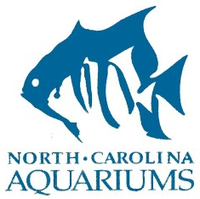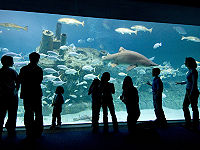- North Carolina Aquariums
-
North Carolina Aquariums 

A "Live Dive!" program at the North Carolina Aquarium at Pine Knoll Shores.Date opened 1976 Volume of largest tank 306,000 US gallons (1,160,000 l; 255,000 imp gal) Memberships AZA[1] Website www.ncaquariums.com North Carolina Aquariums is a system of 3 public aquariums located in Kure Beach, Roanoke Island and Pine Knoll Shores. All are operated by the Aquariums Division of the North Carolina Department of Environment and Natural Resources since 1976 and are accredited by the Association of Zoos and Aquariums.[2] All three aquariums feature dive shows, live animal encounters, and feeding programs.
Contents
North Carolina Aquarium at Fort Fisher
The focus of the North Carolina Aquarium at Fort Fisher, in Kure Beach, is to educate visitors about the waters of the Cape Fear region. The Cape Fear Conservatory, the visitor’s first stop in the aquarium, features freshwater life. In this large, tree-filled atrium, streams, ponds and swamps are home to frogs, snakes, bass, catfish, and perch. Box turtles hide among the Conservatory’s groundcover. American alligators native to North Carolina occupy one of the larger exhibits in the Conservatory. An albino alligator exhibit opened in 2009. In 2006, the aquarium opened an exhibit featuring the venomous snakes of the region, including several species of rattlesnake, copperheads, and cottonmouths.
The Coastal Waters Gallery, which includes the Coquina Outcrop Touch Pool, provides hands-on opportunities to learn about sea urchins, horseshoe crabs, whelks, and other creatures of a rocky outcrop surf zone. Masonboro Inlet Jetty features the fishes common around a wave-washed rock jetty, an indoor salt marsh, a sea horse habitat, and a loggerhead sea turtle display.
The Open Oceans Gallery includes Sharkstooth Ledge, which features fish common to offshore North Carolina, such as pufferfish, hogfish, and filefish. The gallery also displays octopus, jellyfish, and corals native to the state's waters. A new multimedia suite features an extinct whale-eating shark called Megalodon. This exhibit, opened on July 1, 2011, includes projections on a 23-ft curved screen, as well as interactive holograms and touch-screen interfaces.
Holding 235,000 US gallons (890,000 l; 196,000 imp gal), Cape Fear Shoals is the largest of the aquarium’s saltwater exhibits. The 24-foot (7.3 m)-deep replica of an offshore reef affords two-story, multi-level views of large sharks, stingrays, groupers, and moray eels.
The Exotic Aquatics Display features animals native to Indo-Pacific and other ocean regions. These displays include spiny lobsters, the red lionfish (Pterois volitans), and a North Carolina native, the spotted scorpionfish. They are both known for their inconspicuous, venomous spines. Lionfish are native to the Indian and Pacific Oceans, but in 2000 were confirmed as having established themselves in North Carolina. Australian spotted jellies, recently invasive in U.S. coastal waters, are among the gallery's newer exhibits.
The 550-US-gallon (2,100 l; 460 imp gal) Pacific Reef Display features living corals, giant clam, anemones, cardinalfish, hawkfish, clownfish, wrasses, surgeonfish, and nearly a dozen other fish species.
Expansion
The facility closed in November 1999 for a major expansion and reopened in March 2002. The new construction increased the size of aquarium systems from 77,000 US gallons (290,000 l; 64,000 imp gal) to 455,000 US gallons (1,720,000 l; 379,000 imp gal). The expansion included the creation of the Cape Fear Shoals tank, a 235,000-US-gallon (890,000 l; 196,000 imp gal) exhibit recreating the hard bottomed coral reefs off the coast of North Carolina.
North Carolina Aquarium at Pine Knoll Shores
Since reopening, the North Carolina Aquarium at Pine Knoll Shores has continued to feature aquatic animals of North Carolina. Notable among them are two sand tiger sharks – one that measures nearly nine feet long, a green moray eel measuring about six feet long, a goliath grouper approaching four feet, and a number of sizable nurse sharks, sandbar sharks and various game fishes.[2]
Most of the larger creatures inhabit the Aquarium’s centerpiece exhibit, the 306,000-US-gallon (1,160,000 l; 255,000 imp gal) Living Shipwreck. Along with hundreds of schooling fishes and other animals, they create a swirl of constant motion around a replica of U-352, a German submarine that lost a World War II battle with a Coast Guard cutter off the North Carolina coast.[3] The Aquarium’s two river otters also have lived up to expectations of stardom. With the help of the public, the two were named Neuse and Pungo after North Carolina rivers. Wide viewing windows bring their playful antics and underwater agility to child-eye-level, and the lively pair enchants people of all ages.
The North Carolina Aquarium also features two hands-on exhibits: the Tidal Touch Pool, featuring a large variety of aquatic invertebrates, and Skate and Ray Encounters.[4]
Visitors can get a glimpse of the North Carolina Aquarium’s successful sea turtle rehabilitation program in the Sea Turtle Odyssey exhibit. Each year, weak sea turtle hatchlings from nearby beaches are brought by the state Wildlife Resources Commission to the North Carolina Aquarium. Once there, they are rehabilitated and often put on exhibit until they can be released back into the wild. Some of the turtles' travels are recorded daily via satellite tag and viewable to the public.[5]
Throughout the year the North Carolina Aquarium offers free daily programs, including: live animal programs, animal feeding presentations, a "Live Dive!" show, puppet shows, quiz games and hands-on activities. A number of special activities are available for a small fee. In the summer, beginning June 1, the North Carolina Aquarium offers snorkeling, surfing classes, night treks to search for nesting sea turtles, on board collection and river cruises, kayaking and canoeing excursions, and fishing courses. Kayaking, canoeing and fishing programs continue into the fall, when seafood cooking classes are also offered. Behind-the-scenes tours, Dinner with the Critters, and Breakfast with the Rays are offered year-round.
North Carolina Aquarium on Roanoke Island
The North Carolina Aquarium on Roanoke Island is a 68,000-square-foot (6,300 m2) facility located on the Outer Banks. The focus of the aquarium is the sealife and ecosystems in the waters of the Outer Banks as well as the weather that affects it. Galleries include, Coastal Freshwaters, Wetlands on the Edge, Hurricanes and Northeasters, Marine Communities, Close Encounters, Open Ocean, and Oceans Revealed: Powers of the Planet.[6]
Jennette's Pier
In 2002, the NC Aquarium Society purchased Jennette’s Pier in Nags Head, the oldest pier along the Outer Banks, with plans to refurbish it as an outreach site. Those plans were put on hold in September 2003, when Hurricane Isabel destroyed the structure. Plans were made to completely rebuild Jennette’s as a concrete structure with a 1,000-foot (300 m) pier. $25 million was set aside for construction which began in early 2009. On May 21, 2011, Jennette's Pier was finally reopened to the public. Programs such as recreational fishing, field trips and extension education are conducted at the pier. There are plans to build two other piers near the aquariums at Fort Fisher and Pine Knoll Shores, but money has not been allocated for construction. [7][8]
Notes
- ^ "List of Accredited Zoos and Aquariums". aza.org. AZA. http://www.aza.org/current-accreditation-list/. Retrieved 11 July 2011.
- ^ a b "Welcome to the North Carolina Aquarium at Pine Knoll Shores" (Press release). North Carolina Aquarium at Pine Knoll Shores. http://www.ncaquariums.com/pks/mediakit/PKS%20Aquarium%20Information%20Packet.pdf. Retrieved 2008-03-14.
- ^ Hall, Martha and Tabbie Nance. Insider’s Guide: North Carolina’s Central Coast and New Bern. 2007. Page. 104.
- ^ Hall, 2007
- ^ seaturtle.org - Satellite Tracking
- ^ "North Carolina Aquarium on Roanoke Island". http://www.ncaquariums.com/roanoke-island. Retrieved 2009-09-23.
- ^ "Aquarium Piers". http://www.ncaquariums.com/aquarium-piers. Retrieved 2009-09-23.
- ^ "Jennette's Pier Reconstruction Now Underway". Press Release (Town of Nags Head). July 8, 2009. http://www.townofnagshead.net/index.asp?Type=B_PR&SEC={4C25AA5A-7376-4E36-8405-78E760F242E2}&DE={04C7D29C-37F3-4219-A949-9A18F4537447}. Retrieved 2009-09-23.
External links
Zoos and aquaria of North Carolina Aquariums Zoos - Duke Lemur Center
- JB's Rattles Traveling Reptile Zoo
- Museum of Life and Science
- Natural Science Center of Greensboro
- North Carolina Zoo
- Triangle Metro Zoo
- Western North Carolina Nature Center
Zoos, aquariums, and aviaries Types of zoos Conservation Lists Animals Other topics - Animals in captivity
- Animal training
- Behavioral enrichment
- Captive breeding
- Frozen zoo
- Immersion exhibit
- Nocturnal house
- Wildlife conservation
- Zookeeper
- Zoology
- Portal
- Project
- Category
- Commons
The Outer Banks of North Carolina Landforms Places Currituck County · Dare County · Hyde County · Carteret County
Carova Beach · Corolla · Duck · Southern Shores · Kitty Hawk · Kill Devil Hills · Nags Head · Manteo · Wanchese · Rodanthe · Waves · Salvo · Avon · Buxton · Frisco · Hatteras · Ocracoke · PortsmouthWaterways Lighthouses Protected areas Transportation History Places Waterways Protected areas Transportation Categories:- Crystal Coast
- Aquaria in North Carolina
- Wilmington, North Carolina
- Buildings and structures in New Hanover County, North Carolina
- Buildings and structures in Dare County, North Carolina
- Buildings and structures in Carteret County, North Carolina
- Visitor attractions in New Hanover County, North Carolina
- Visitor attractions in Dare County, North Carolina
- Visitor attractions in Carteret County, North Carolina
Wikimedia Foundation. 2010.




